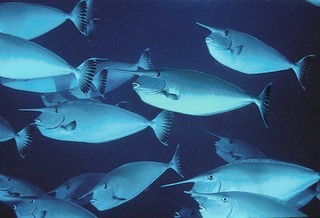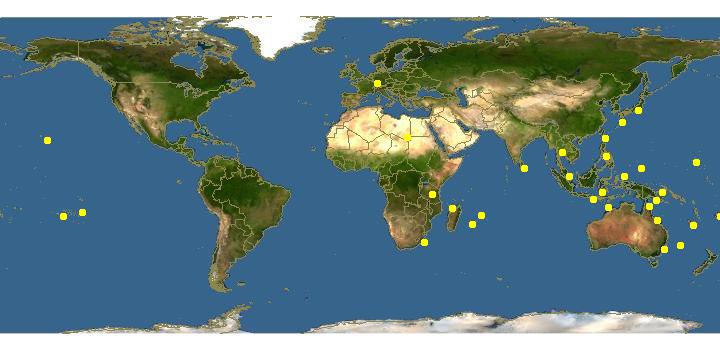|
| Links |
We parsed the following live from the Web into this page. Such content is managed by its original site and not cached on Discover Life. Please send feedback and corrections directly to the source. See original regarding copyrights and terms of use.
- Australian Faunal Directory
- FishBase
|
|
español |
|
|
Overview |
Main identification features
- horn very long
- blue-grey
- tail fin black + pale membranes and edges
- tail base: 2 keels
Body elongate, oval; snout pointed, slopes at about 60°; adult with long, tapering horn before eye that can extend 1 head length forward (a bump on forehead of juveniles); teeth small, conical, with tips slightly depressed, smooth or with slight denticulations; 2 pairs of cutting keels on plates on narrow tail base; pelvics I, 3; tail edge straight, a series of small scallops on rear margin, long filaments from top and bottom in males (straight in juveniles); dorsal VI, 28-29; anal II, 27-28; pectoral 17-19 rays.
Uniform olive to brown; can switch on pale blue color; tail with wide rays blackish, membranes between rays, narrow margin, and filaments white. Juveniles with thin white dorsal and anal margins, a white saddle on the caudal peduncle, tail dark with white margin.
Size: 100 cm.
Habitat: juveniles and subadults benthic on reefs and rocky shores, adults in open water near exposed reef fronts.
Depth: 0-122 m; subadults usually 5-15 m, adults usually 10-30 m.
An Indo-Pacific species recorded as a vagrant from Cocos and Clipperton Atoll.
Attributes
Abundance: Common.
Cites: Not listed.
Climate Zone: Equatorial (Costa Rica to Ecuador + Galapagos, Clipperton, Cocos, Malpelo).
Depth Range Max: 122 m.
Depth Range Min: 0 m.
Diet: pelagic fish larvae; zooplankton; benthic microalgae.
Eastern Pacific Range: Northern limit=11; Southern limit=6; Western limit=-110; Eastern limit=-87; Latitudinal range=5; Longitudinal range=23.
Egg Type: Pelagic; Pelagic larva.
Feeding Group: Omnivore; Planktivore.
FishBase Habitat: Reef Associated.
Global Endemism: All Pacific (West + Central + East); Indo-Pacific only (Indian + Pacific Oceans); TEP non-endemic; "Transpacific" (East + Central &/or West Pacific); All species.
Habitat: Corals; Reef associated (reef + edges-water column & soft bottom); Rocks; Reef (rock &/or coral); Reef only.
Inshore Offshore: Inshore; Inshore Only.
IUCN Red List: Not evaluated / Listed.
Length Max: 100 cm.
Regional Endemism: Island (s) only; Island (s); Tropical Eastern Pacific (TEP) non-endemic; Eastern Pacific non-endemic; All species.
Residency: Vagrant.
Salinity: Marine; Marine Only.
Water Column Position: Bottom; Mid Water; Near Bottom; Bottom + water column;
|
|
|
Names | |
|
|
|
Links to other sites | |
|
|
|
References |
- Allen , G.R. and Robertson, D.R., 1997., An Annotated Checklist of the fishes of Clipperton Atoll, Tropical Eastern Pacific., Revista de Biologia Tropical, 45:813-843.
- Osburn , R. C. and Nichols, J. T., 1916., Shore Fishes Collected by the 'Albatross' Expedition in Lower California with Descriptions of New Species., Bull. Amer. Mus. Nat. Hist., 35:139-181.
- Quoy , J. R. C. and Gaimard, J. P., 1824., Description des Poissons. Chapter IX. In: Freycinet, L. de, Voyage autour du Monde...exécuté sur les corvettes de L. M. "L'Uranie" et "La Physicienne," pendant les années 1817, 1818, 1819 et 1820. Paris., Voyage Uranie, Zool., :1-328.
- Robertson , D.R. and Allen, G.A., 1996., Zoogeography of the shorefish fauna of Clipperton Atoll., Coral Reefs, 15:121-131.
- Smith , M. M. and Heemstra, P., 1986., Smith's Sea Fishes. Johannesburg: Macmillan South Africa. 1047 pp., Macmillan South Africa:1047pp.
|
|
|
Acknowledgements | |
I thank Ashley MacDonald and John Pickering, University of Georgia, for technical support in building this page.
|
|
| Supported by | |
|
Following modified from Australian Faunal Directory
|
Top | See original
| &pull 20q v5.145 20180528: Error 301 Moved Permanently http://biodiversity.org.au/afd/taxa/daa118ea-4bcf-42b0-ada6-5df92aa5f5ce/ |
|
Following modified from FishBase
|
Top | See original
http://www.fishbase.org/Summary/speciesSummary.php?genusname=Naso&speciesname=annulatus ---> http://192.134.151.83/Summary/speciesSummary.php?genusname=Naso&speciesname=annulatus
http://192.134.151.83/Summary/speciesSummary.php?genusname=Naso&speciesname=annulatus ---> https://fishbase.mnhn.fr/Summary/speciesSummary.php?genusname=Naso&speciesname=annulatus
&pull 20q v5.145 20180528: Error 501 Protocol scheme 'https' is not supported (LWP::Protocol::https not installed) https://fishbase.mnhn.fr/Summary/speciesSummary.php?genusname=Naso&speciesname=annulatus |
Updated: 2024-04-19 21:13:23 gmt
|

